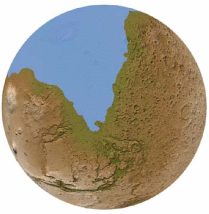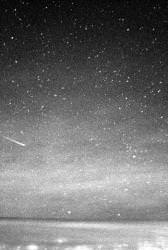Imagine if astronomers could tell the difference between Earth-like extrasolar planets just by seeing the reflected light from their oceans? That sounds like science fiction, but a team of researchers have proposed that it’s really possible to detect the shape of the light curve glinting off an extrasolar planet and know if it has oceans.
This ground-breaking (water splashing?) idea was written in a recent journal article by D.M. Williams and E. Gaidos, entitled Detecting the Glint of Starlight on the Oceans of Distant Planets published January, 2008 in the Arxiv prepress e-Print archive.
The article describes the methods astronomers could use to detect the glint, or water reflection, from the “disk-averaged signal of an Earth-like planet in crescent phase.” They used the Earth as an example, and generated a series of light curves for a planet with our orientation and axial tilt.
They calculated that planets partially covered by water should appear much brighter when they’re near the crescent phase because light from the parent star reflects off the oceans very efficiently at just the right angles. By watching an extrasolar planet move through its orbit, its light curve should give off the telltale signature that there are oceans present.
According to their calculations, this method should work for about 50% of the visible planets. Furthermore, it should be possible to measure the ratio of land to water, and even get a sense of continents.
In order to test their theories, they’re planning to use remote observations of Earth, using interplanetary spacecraft. This will demonstrate if Earth can be observed at extreme phase angles—orbiting spacecraft around or on route to Mars.
And then the upcoming planet hunting missions, such as Darwin and the Terrestrial Planet Finder (if it ever gets completed) should be able to make the direct analysis of Earth-sized worlds orbiting other stars. Just by measuring the brightness, they should know if there are oceans, boosting the prospects for life.
Original Source: Arxiv


